최근 뉴스
제품 카테고리
더운 제품
-
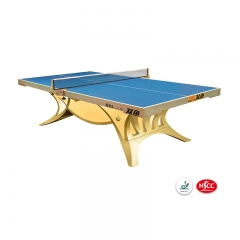
Volant King 챔피언 쉽 프리미엄 탁구대
이 프리미엄 탁구대는 선수권 대회에 적합합니다. ITTF와 NSCC가 승인 함. 실버 하체 구성 + 푸른 빛
더 읽어보기 -

토너먼트 Volant Dream 2 공식 테이블 테니스 테이블
더블 피쉬 스포츠 (Double Fish Sports)가 디자인 한 국제 경기 용 탁구대 Volant Dream 2.
더 읽어보기 -
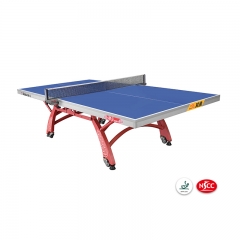
Competitons 공식 테이블 테니스 테이블 XIANGYU 328
프리미엄 더블 Foldable 휴대용 탁구 테이블, 컴팩트 한 디자인 새로운 접는 시스템은 테이블 보관 및 이동 중에 부상 위험을 최소화합니다. ITTF는 탁구대를 승인했습니다.
더 읽어보기 -
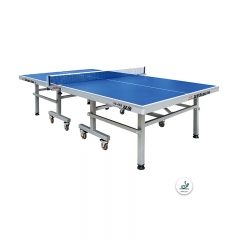
세계 투어 99-45B를위한 공식적인 내구재 탁구 테이블
ITTF는 국제 토너먼트에서 공식 테이블 테니스 테이블을 승인했습니다. 테이블 보드의 두께 : 25mm 투수 품질 -이 전문가 수준의 테이블은 최고 수준의 경쟁을 위해 설계되었습니다. 완벽한 가족 - 모든 연령층에게 프리미엄 게임을 제공합니다. 일대일로 나가거나 개인 연습을 위해 접으십시오. 2 인치 무거운 게이지 강철 지지대는 가장 까다로운 문제를 방지합니다. 게임 룸, 덴 또는 체육관을위한 훌륭한 중심입니다. 손쉬운 조립 - 간단한 조립으로 몇 분 안에 시작하십시오. 고품질의 네트에는 쉽게 부착 할 수있는 잠금 클램프가 장착되어 있습니다.
더 읽어보기 -
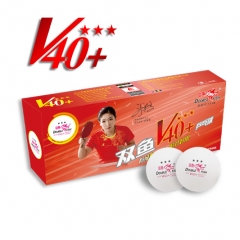
최고의 품질 이중 물고기 V40 + Volant 3 별 탁구 공
Double Fish V40 + Volant 3 Stars 탁구 공은 ITTF의 최신 T3 기술 표준에 확인됩니다.
더 읽어보기 -
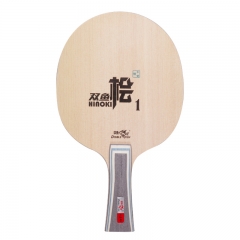
이중 물고기 QIJI 만능 탁구 블레이드
더블 피쉬 QIJI 만능 탁구 블레이드, 가장 잘 팔리는 탁구 탁구 블레이드, & nbsp; 완벽한 allround 선수를위한 완벽한
더 읽어보기
원산지 추적 | 광저우 탁구공장 개발(2부)

1960년 가을부터 청공탁구공장은 2년여에 걸친 기술혁신을 통해 1963년 말까지 기본적으로 공장의 주요 생산공정을 기계화하고 제품 생산량과 품질을 향상시키며 제품을 수출하기 시작했습니다. 1963년 생산량은 320만개로 1960년 78만개(5만8400개)의 3배가 넘는다.
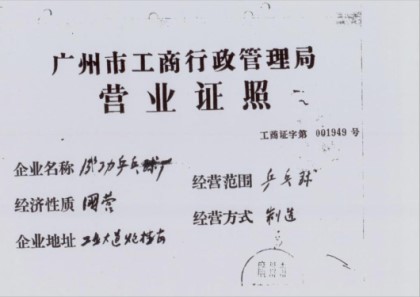
청공탁구공장 영업허가증
① 이 글의 내용은 주로 청공탁구공장의 역사적 자료와 『광저우시실기』 제5권(1부) 303~304쪽을 바탕으로 작성되었습니다.
그러나 청공탁구공장의 생산이 호황을 누리는 것과 동시에 폴로사원 지역의 수자원 부족이 새로운 문제가 되어 추가 개발을 제한했습니다. 결국 상급 부서는 물 부족 문제를 해결하고 생산 규모를 더욱 확대하기 위해 청공 탁구 공장을 허난 산업 거리 ② 옆 파오루강으로 이전하기로 결정했습니다. 이번 이전은 Chenggong Factory 개발의 새로운 장을 열었습니다.
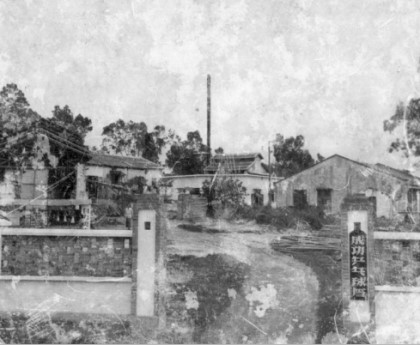
청공탁구공장 하이주구 옌쯔강으로 이전
②Henan Industrial Avenue 옆의 Paolougang은 현재 Haizhu District의 Yanzigang 지역입니다. 1952년부터 광저우 교외 "허난"이 광저우의 중요한 산업 기지로 건설되었습니다. 이 거리는 한때 광저우 산업의 중심지였으며 많은 국내 최초 제품을 탄생시켰습니다. 전성기에는 5.5km 길이의 공업대로에서 만보냉장고, 타이거헤드 배터리, 우양자전거 등 전국적으로 유행하는 제품을 생산했다. 청공탁구공장이 이전한 부지는 원래 도자기 공장이었다. , 이미 기본 공장 시설을 갖추고 있어 생산 확대에 편리함을 제공했습니다. 우수한 부서의 전폭적인 지원으로 청공 탁구 공장은 토지를 구입하고 건설을 시작하여 미래 발전을 위한 견고한 기반을 마련할 수 있었습니다.
1965년 청공탁구공장은 우리나라 최초의 광전식 볼 계량기를 개발하여 또 다른 성공을 거두었습니다. 이후 자동중심측정기, 상표자동인쇄기, 자동단면사절기, 자동측정기 등을 잇달아 제작하여 동종업계의 반자동 및 자동탁구 생산을 전국적으로 실현하는데 앞장섰습니다. 1966년에는 탁구공 생산량이 1,000만개를 돌파했다. 문화대혁명 기간에는 일부 공장과 합병해 사이리스터도 생산했다.
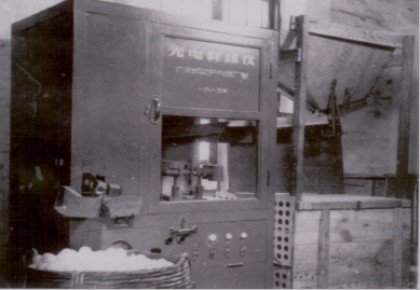
1965년 청공탁구공장은 중국 최초의 광전식 볼 계량 장비를 개척했습니다.

청공탁구공장에서 개발한 자동 라벨 인쇄기
1968년 지방정부의 지원과 협조로 청궁탁구공장은 화다배드민턴공장 (3) , 진둥스포츠용품공장 (4) 과 합병되어 기업의 생산성을 크게 향상시켰다. 그 후 1969년에 공장 이름을 광저우 스포츠 용품 공장으로 변경하여 제품 카테고리와 사업 범위를 확장했습니다.
③ 『광저우시실록』에 따르면 광저우에서 배드민턴 생산은 1950년대 초부터 시작됐다. 배드민턴의 부흥과 함께 생산가계는 지속적으로 발전하고 점차 조직화되었다. 1956년 영젠배드민턴생산협동조합과 위펑생산협동조합이 결성되었다. 1960년에 영젠협회는 화다 배드민턴 공장으로 이름이 바뀌었고 직원 수는 100명이었습니다. 1964년 Yufeng Society의 World Games 브랜드 배드민턴이 광저우의 유명 브랜드 제품으로 평가되었습니다. "문화대혁명" 기간 동안 모든 배드민턴 생산 협동조합은 청공탁구공장으로 통합되었습니다.
④전동스포츠용품공장에서는 주로 나무 손잡이 줄넘기, 탁구 네트, 배구 네트를 생산합니다. 합병 전 두 공장은 도시 지역의 거리에 위치해 있었고, 공장 건물(모두 오래된 주거용 건물)이 산재하고 협소해 자재 운송 및 관리가 매우 불편했습니다. 합병으로 인해 해당 제품의 생산 조건이 개선되었습니다. 이 글은 광저우탁구공장 퇴직 지도자들의 구술을 바탕으로 작성되었습니다.
1972년에 회사 이름을 광저우 탁구공장으로 바꾸었습니다. 같은 해 광저우 탁구 공장은 혁신적인 왁스 팽창 방식을 도입하여 밀착 심 볼 생산을 위한 기존의 스팀 공정을 대체하여 작업 효율성을 두 배로 높였습니다. 이 기술의 도입으로 생산 효율성이 향상되었을 뿐만 아니라 광저우 탁구 공장은 중국에서 밀착 심 공 생산의 완전한 기계화를 달성한 최초의 회사가 되었습니다.

1970년대 중반 탁구공 확장기
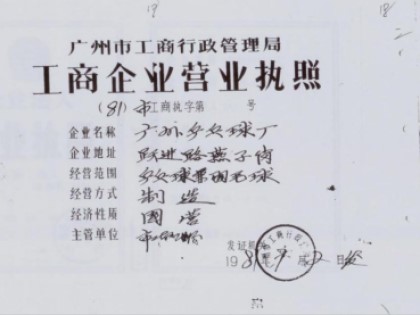
광저우탁구공장 영업허가증
1974년, 5개월 간의 끊임없는 노력과 130회 이상의 정밀 테스트 끝에 광저우 탁구 공장은 중국 최초의 하드 탁구공을 개발하는 데 성공했습니다 . 이 성과는 중국 탁구 제조 기술의 획기적인 발전을 의미합니다. 이후 이 제품은 "Shuangyu 브랜드"로 명명되었습니다. 1979년에 이 탁구공은 국제탁구연맹의 공식 승인을 받아 국제 공식 대회 지정구가 되었습니다.
In 1980, "Double Fish" brand table tennis balls were officially rated as a national famous trademark and won the National Gold Award in the same year.
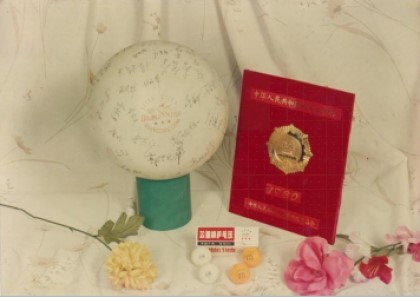
Doublefish table tennis won the national gold medal certificate
In 1981, with the booming domestic and foreign markets for badminton, the Guangzhou Table Tennis Factory restarted the production of badminton with the formal approval of the competent authorities. It focused on creating special balls for high- and mid-end competitions, strictly selected high-quality white goose feathers, and used imported cork and artificial leather as ball head materials to produce badminton with excellent whiteness, strong flight stability, and precise landing points. All products were sold to the Japanese market.
From 1986 to 1990, the annual output of badminton achieved an average high growth rate of 31%. In 1989, advanced Japanese production equipment was introduced, which greatly improved the production capacity and reached an annual production capacity of 24 million. In 1987, the Jinque brand badminton in the domestic market was rated as a high-quality product by the Ministry of Light Industry, and in 1990 it won the official certification of the national competition ball, marking the full recognition of product quality and technical level.
In 1986, as sales continued to expand, Guangzhou Table Tennis Factory set up branch factories in Zengcheng and Huaxian (now Huadu District, Guangzhou), focusing on producing mass-market table tennis balls to meet domestic market demand, while the main factory was committed to producing mid- and high-end table tennis balls for export. In 1987, total production soared to 63.02 million, of which 54.82 million were sold to overseas markets, generating US$2.18 million in foreign exchange revenue.
In 1988, the outstanding performance of Guangzhou Table Tennis Factory won the honorary titles of Provincial Advanced Enterprise and National Second-Class Enterprise. In 1990, Guangzhou Table Tennis Factory invested 2.5 million yuan in factory construction and technical transformation to further improve production capacity. In November of the same year, a new celluloid sheet plant was established in Zengcheng with an investment of nearly 2.57 million yuan. Through this series of transformation and expansion, the annual production capacity of table tennis balls doubled from 60 million to 120 million, making Guangzhou Table Tennis Factory one of the important bases for table tennis ball production in the world.
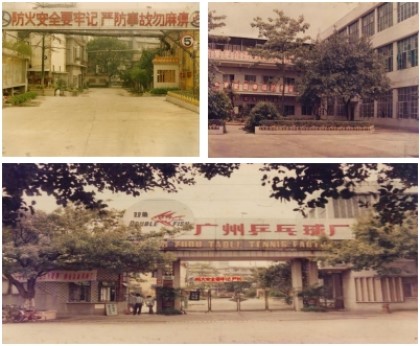
Guangzhou Table Tennis Factory in the 1990s
In 1994, the company relocated and expanded again⑤, requisitioned 50 mu of production land in Dabu Management District, Mayong Town, Dongguan City, relocated and renovated it, expanded its production scale, and achieved rapid improvement in production quality, laying a solid foundation for the company's sustainable development.
⑤ 탁구 제조 원료인 셀룰로이드의 주성분은 니트로셀룰로오스이기 때문에 이 물질은 인화성이 매우 높아 상하이 복희탁구공장과 천진공장 화재사고를 비롯해 중국에서 심각한 화재사고를 많이 일으켰다. 탁구공장. 1993년 10월 14일에는 광저우 탁구공장에도 화재가 발생해 건물 4000㎡가 전소됐다. 또한, 1990년대 Yanzigang 주변 주거 지역의 급속한 성장으로 인해 이 지역의 안전 위험이 점점 더 두드러졌습니다. 이를 고려하여 광저우 탁구 공장은 더 높은 안전 표준과 생산 효율성을 보장하기 위해 생산 라인을 완전히 이전하고 둥관으로 이전하기로 결정했습니다.
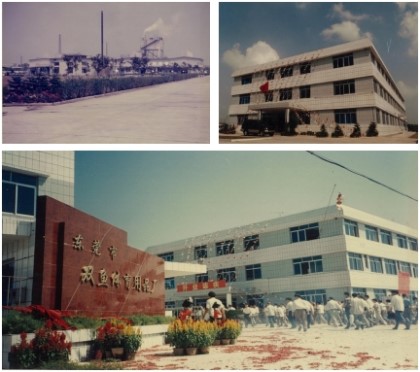
1990년대 동관공장
1995년에 "Doublefish" 브랜드 의 상당한 영향력을 바탕으로 광저우 탁구 공장은 공식적으로 이름을 광저우 Doublefish 스포츠 용품 공장으로 변경했습니다.
1998년 2월 26일, 광저우 쌍우 스포츠 용품 공장은 광저우 쌍우 스포츠 용품 그룹 유한회사에 합병되었습니다.























 Overseas business:(020)8431 9554
Overseas business:(020)8431 9554
 13829778212
13829778212